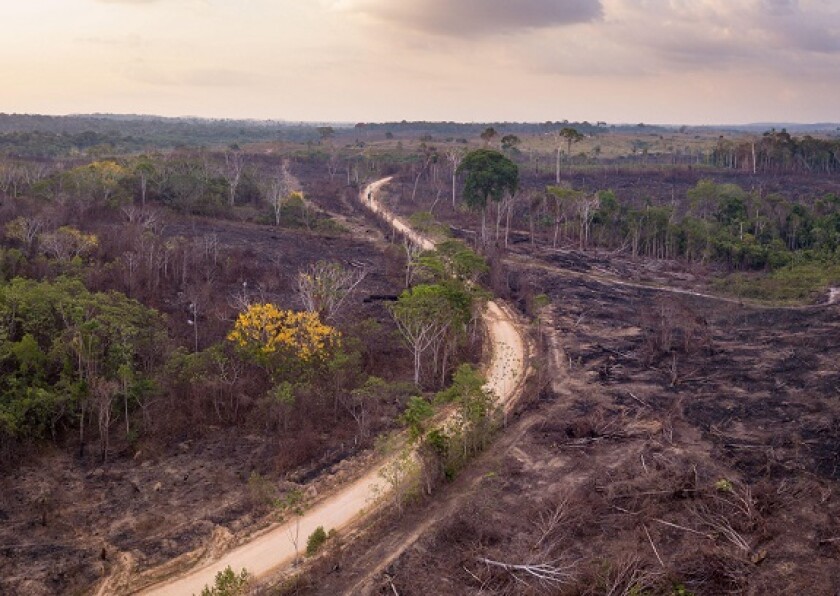Campaigners working to save the world’s forests were torn between cheer and dismay on Tuesday as the issue took centre stage at COP26 with a global agreement of 100 countries. The deal gives nature-based solutions to climate change a much higher profile than at previous summits. But environmentalists say the planned action is not nearly big or fast enough to save regions such as the Amazon, which are severely endangered.
In parallel with the government announcement, investors including Aviva, Axa and Legal & General have made a new, parallel pledge to eliminate deforestation from their portfolios by 2025.
“We’ve seen for more than a decade that efforts at paying forest-rich developing countries to preserve forests can be really successful, but they have not attracted the necessary level of funding quickly enough,” said Vemund Olsen, senior sustainability analyst at Storebrand, the Norwegian investment firm that has helped assemble the investor coalition (see separate story). “The initial hope in forest nations that there would be a strong willingness from developed nations to compensate them for not deforesting has not been fulfilled. Now there appears to be a renewed willingness to put money behind it.”
Presidents Joe Biden of the US, Joko Widodo of Indonesia, Ivan Duqué of Colombia and Félix Tshisekedi of the Democratic Republic of Congo spoke at the launch on Tuesday of the Glasgow Leaders’ Declaration on Forests and Land Use — as did the Prince of Wales and UK prime minister Boris Johnson.
GlobalCanopy, the forest campaign group, was delighted with the breadth of the agreement, which its executive director Niki Mardas hailed in a statement as “ambitious and far-reaching”. He hoped it would be more successful than the 2014 New York Declaration on Forests.
Big players in
Countries holding 85% of the world’s forests, including Brazil, Russia and Canada, have joined the agreement to halt and reverse deforestation and land degradation by 2030.
Also in the pact are China and the EU, major consumers of the commodities that often lead to deforestation — meat, wood, paper, soya, palm oil and cocoa.
In a statement on the deal, the UK prime minister’s office said forests absorbed a third of the carbon emissions from burning fossil fuels, but humans were destroying 27 football pitches’ worth of woodland every minute. Some 23% of all global greenhouse gas emissions come from land use, including agriculture and deforestation.
As with so many climate issues, the distribution of costs and benefits is sharply skewed. While all humans need forests to be preserved, the opportunity cost of doing so, rather than cutting them down to grow cash crops or food — or to exploit the land for minerals, tourism or urbanisation — is borne entirely by the countries where forests grow.
This situation begs for an international mechanism to share out the costs, and the Glasgow Declaration could form the seed of one.
Twelve wealthy countries have pledged to pay $12bn between now and 2025 to finance forest protection projects in the developing world, including restoring degraded land, tackling wildfires and supporting the rights of indigenous communities.
Private sector institutions are putting up another $7.2bn. The UK’s contribution is £1.5bn.
But forest specialists’ welcome for the deal is mixed with concern. Tyson Miller, director of forest programmes at Stand.Earth, a forest campaign and research group, who is based in Asheville, North Carolina, said in a statement that the deal was “not fast or bold enough”.
The money pledged was not enough, he said, to meet the climate goals of the Paris Agreement, which would mean spending an estimated $45bn to $460bn a year to protect and restore forests.
On the brink
Stand.Earth highlighted three areas of particular danger. “This Declaration’s timeline crucially does not address what is needed in the Amazonian region, which is to end deforestation immediately,” the group said. “Tipping point science tells us that the Amazon biome starts to unravel towards a savannah when it crosses a threshold of 20%-25% deforestation or high disturbance. The Amazonian biome is already in the midst of this tipping point, so ending deforestation nine years from now is far too long a timeline.”
Miller pointed to a more ambitious plan for saving the Amazon. Last month, the IUCN World Conservation Congress in Marseilles passed a motion setting a target of conserving 80% of the forest by 2025. The international coalition behind this plan, which has the support of COICA, the pan-Amazonian indigenous federation, has defined critical priorities, including creating Amazon Biome Emergency Action Plans, expanding indigenous rights and territories, conditioned debt forgiveness, and clean financing and supply chains.
Stand.Earth is about to present new research at COP26 on Wednesday, showing that there are over 200m hectares of primary Amazonian forests that are largely undisturbed and not under any kind of legal protection.
“These areas are in need of immediate protection if this Declaration has any hopes of being more than just optics,” Miller said.
Northern fights
The risks do not just lie in developing countries. Stand.Earth also highlighted that Canada’s primary forests are in peril.
The Glasgow agreement does not prevent countries from cutting down old and even ancient trees, as long as they replant new ones. But this practice is “highly problematic” from an environmental point of view, Stand.Earth said.
“Primary forests represent only one third of forests globally (and shrinking) and need to be prioritised for protection,” the group argued. “As a country with a huge proportion of slow growing primary and old growth forests, Canada needs to address this problem. Over 1,000 people have been arrested in British Columbia this year in attempts to save ancient trees that are thousands of years old.”
A measure of the danger to the boreal forest ecosystem is that populations of caribou or reindeer are declining and on a path to local extinction — “a reminder that this old forest ecosystem is being fragmented and logged at astounding rates,” Stand.Earth said.
It called on the Canadian government to keep 65% of its boreal forest intact.
Legalised destruction
A new threat is also coming from countries such as the UK, Japan, South Korea, Denmark and the Netherlands, which, although signatories to the Forest Declaration, have developed biomass burning power stations.
Burning wood and other plants creates carbon emissions which are often higher than those from coal, per unit of energy. Claims that these do not count because the plants previously extracted the carbon from the atmosphere are usually based on fallacious premises, ignoring the fact that these plants are not new and were already part of the world’s defence against carbon emissions.
The UK gets around 5% of its electricity from the wood-burning Drax power station.
This industry is “impacting standing forests in the US, Canada, Estonia, Vietnam and a range of other countries around the world — increasingly from the global South,” Stand.Earth said.
In Canada, the world’s second largest wood pellet exporter, biofuel production “fragments and degrades critical primary and old growth forests vital for storing carbon,” it said.
The group has found that nearly 2m hectares of old growth are at risk from the wood pellet facilities in British Columbia, of which more than a quarter is habitat for caribou.
Congo hope
A more encouraging note was struck in Glasgow concerning the Congo Basin, the world’s second largest forest and one of the last regions in the world that absorbs more carbon than it emits.
After extensive negotiations, the DRC has agreed an expanded 10 year deal with the Central African Forest Initiative, a UN trust fund that has been helping the country and five others in the region protect their forests since 2015.
CAFI supplied $190m to the DRC in the first period, and from 2021 to 2025 will provide $500m, from the UK, EU, South Korea and five other European countries. The money will support a wide programme of reforms and interventions.
Central Africa has lost 6m hectares of forest since 2001, and the DRC is losing 500,000 hectares a year. The programme aims to first cap deforestation at its average pace in 2014-18 and then begin to reverse it, by regenerating 8m hectares of degraded land.
With extreme poverty affecting many of its citizens, the forest is under pressure from people informally cutting trees for firewood and agricultural land.
Even in the capital Kinshasa, 97% of the 13m inhabitants use wood for cooking every day.
The programme aims to halve wood burning in cities by 2030 and involve local people in protecting forests and in sustainable agriculture.
CAFI could be a model for schemes to protect forests elsewhere in the world.





